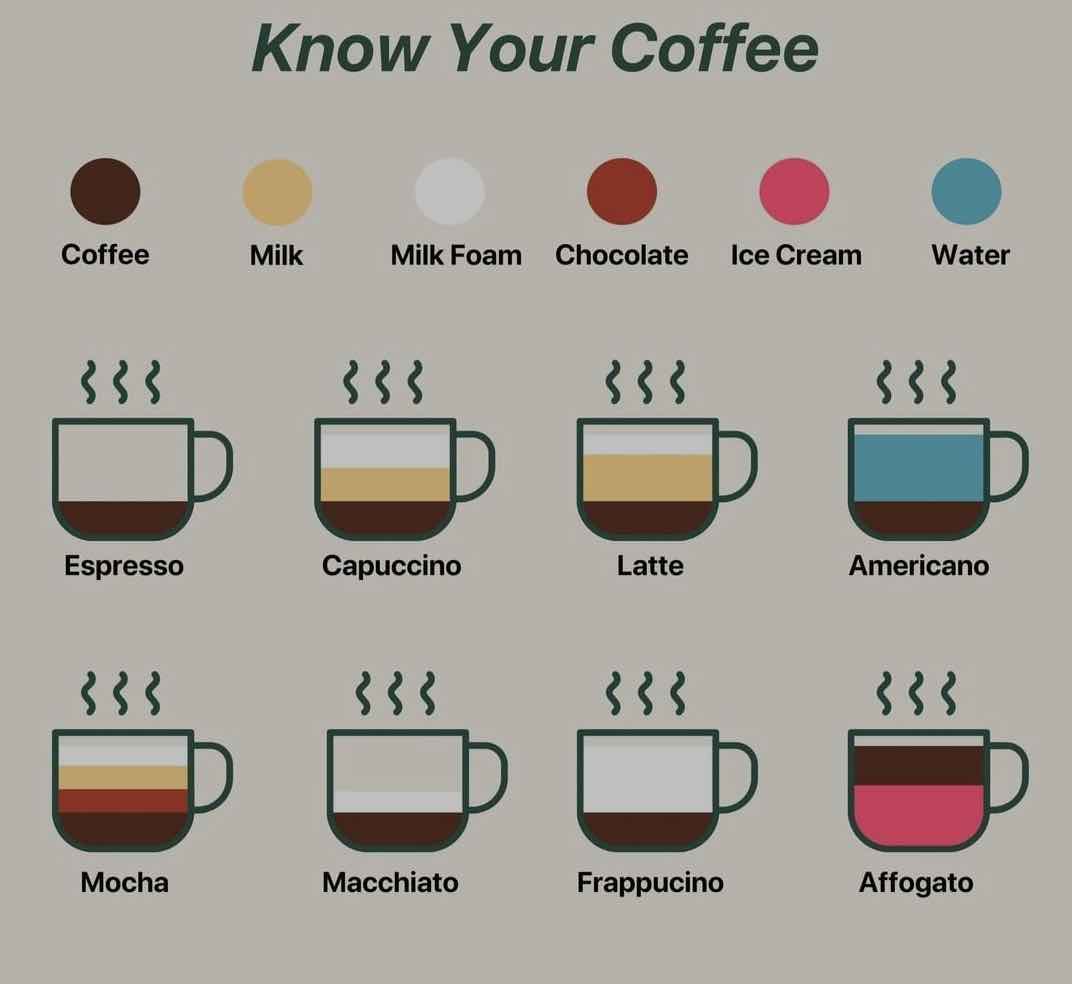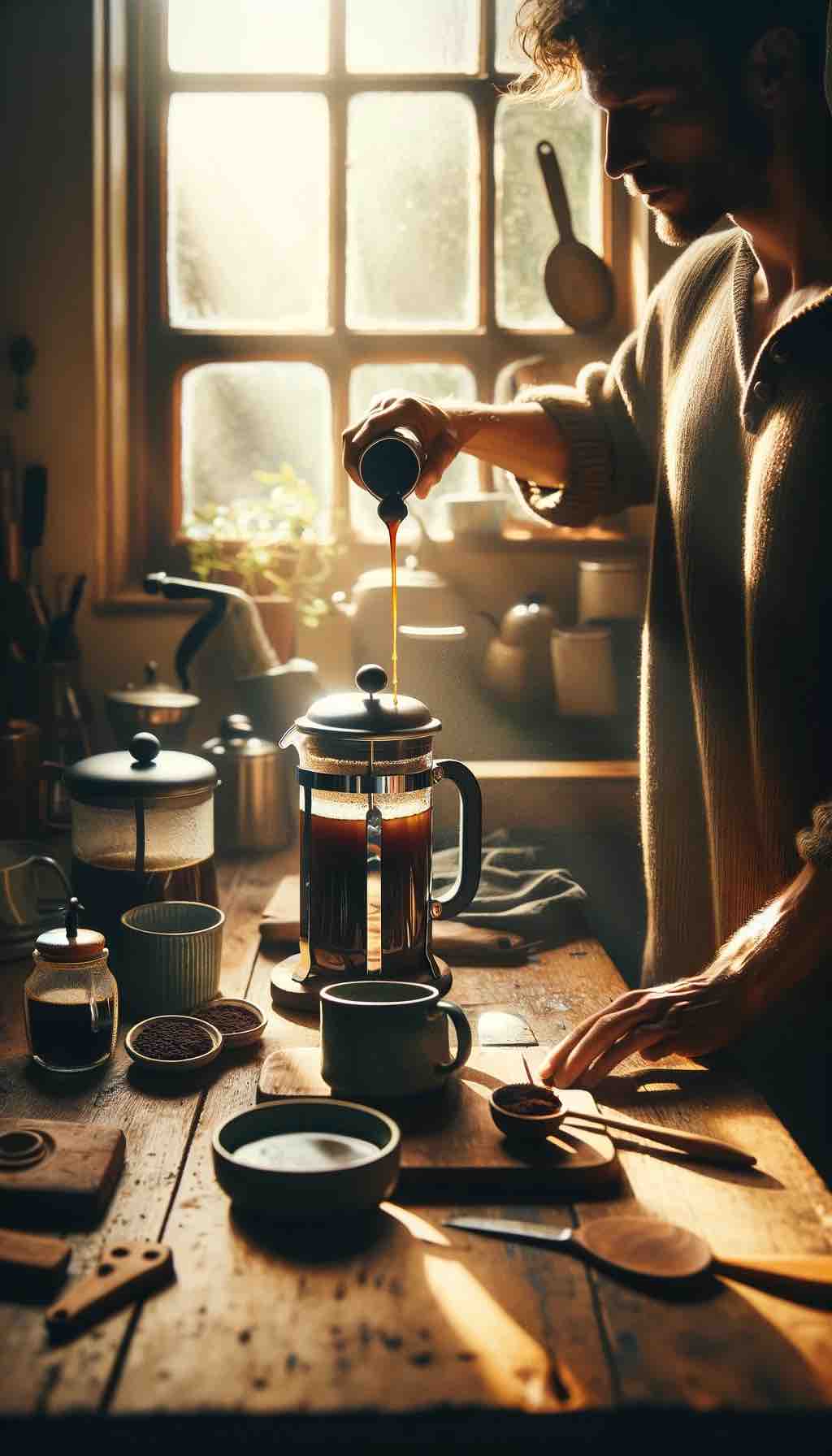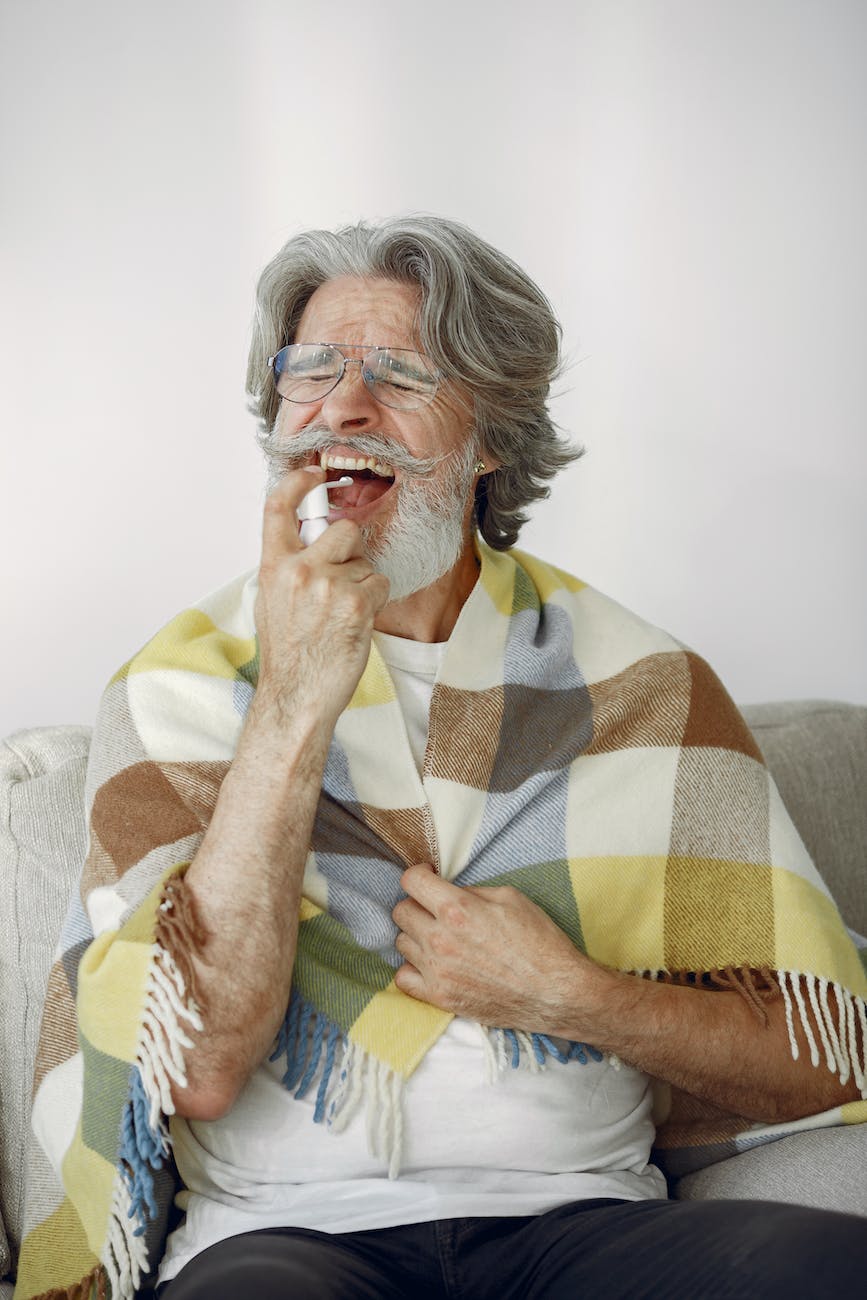
Craving an espresso martini recipe that pours glossy, smells like roasted chocolate, and hits the sweet-bitter balance just right? You’re in the perfect place. Below you’ll find a bar-tested classic plus nine high-demand riffs—Baileys + Kahlúa, Nespresso, salted caramel, citrus with Cointreau, Mr Black/cold brew, Licor 43, peanut-butter whiskey, vegan, and low-cal. Along the way, we’ll use simple ratios you can memorize, practical shaker tips that actually improve foam, and smart substitutions so you can make a great drink with the coffee gear you already own. For festive ideas, circle back to MasalaMonk’s seasonal riffs like the fragrant lineup in 5 Spiced Espresso Martini Recipe Ideas.
Espresso Martini Recipe (Classic, 3-Ingredient)
Why begin here: every variation hangs on this structure. Nail the classic once, then riff with confidence.
Ingredients (one cocktail)
- 60 ml (2 oz) vodka
- 30 ml (1 oz) coffee liqueur (Kahlúa for round sweetness; Mr Black for roastier, drier; Galliano Ristretto for intensity)
- 30 ml (1 oz) fresh hot espresso or 30 ml strong cold-brew concentrate
- Optional: 5–10 ml (¼–⅓ oz) simple syrup (1:1) to taste

Method, step-by-step
- Chill glassware. A coupe or Nick & Nora helps the foam dome stand tall.
- Pull espresso last. Add spirits to a shaker filled with firm, fresh ice; pull the shot now so it’s still lively.
- Shake like you mean it. 12–15 vigorous seconds. You want the tins frosty outside and roaring inside.
- Fine-strain into your chilled glass to catch ice shards that can pop the foam.
- Garnish with three beans for the traditional “health, wealth, happiness” nod.
Texture & balance, explained
Hot espresso carries emulsifiers and suspended oils that whip into foam more willingly; if the shot sits, crema collapses and you lose that café-style head. Meanwhile, the coffee liqueur sets sweetness; adjust syrup in 2–3 ml nudges until the finish reads silky rather than sticky.
Dial-ins (quick wins)
- Drier profile: choose Mr Black; skip syrup.
- Softer edges: stick with Kahlúa; keep 5 ml syrup for roundness.
- Extra body: 1 barspoon demerara syrup (1:1) adds cocoa-molasses depth.
- Salt, barely there: a micro dash of 4:1 saline solution heightens perceived sweetness without more sugar.
For a canonical checkpoint: compare your spec to the IBA espresso martini. If you prefer granular technique talk—hot shots, optional saline, and foam logic—skim Difford’s Guide and adopt what suits your palate.
Espresso Martini Recipe with Baileys & Kahlúa
Now, for something plush. Here, cream meets coffee in a way that reads dessert-adjacent yet still cocktail-clean if you manage dilution thoughtfully.
Ingredients
- 45 ml (1½ oz) vodka
- 30 ml (1 oz) Baileys
- 15 ml (½ oz) Kahlúa
- 30 ml (1 oz) espresso (fresh and hot)
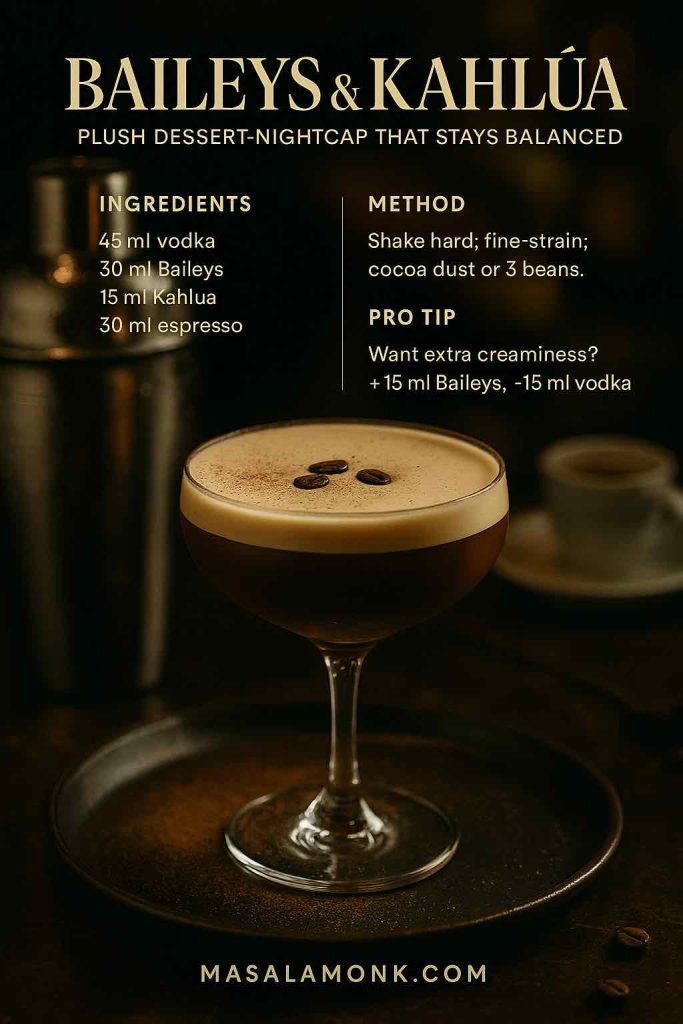
Method
Shake harder than you think—15 to 18 seconds—to emulsify dairy and espresso, then fine-strain. The head should sit thick, and the sip should feel like velvet rather than milkshake.
Why it works
Baileys contributes dairy sweetness and vanilla; Kahlúa fills the coffee mid-palate so you don’t need to drown the drink in syrup. For proportion benchmarks and shake cadence, cross-check the Baileys espresso martini and the Kahlúa method. Then, trim sugar until your finish is clean.
Variations you can pour immediately
- Extra-creamy: +15 ml Baileys, −15 ml vodka.
- Mocha dessert: +5–10 ml crème de cacao; dust cocoa through a fine sieve.
- No-vodka comforter: +15 ml Baileys, +15 ml Kahlúa; shake colder to maintain structure.
While you’re plotting pairings, hop into MasalaMonk’s mix-match guides—What Can You Mix with Kahlúa? and What Mixes Well with Baileys?—for easy flavor ladders you can climb without a grocery run.
Nespresso Espresso Martini Recipe (No Machine, No Problem)
Not everyone has a portafilter at home; nevertheless, pod machines can be stellar. In fact, their crema and consistency are gifts to the shaker.
Ingredients
- 60 ml (2 oz) vodka
- 30 ml (1 oz) coffee liqueur
- 40 ml (1⅓ oz) Nespresso lungo or double espresso, cooled 2–3 minutes (dark pods shine)
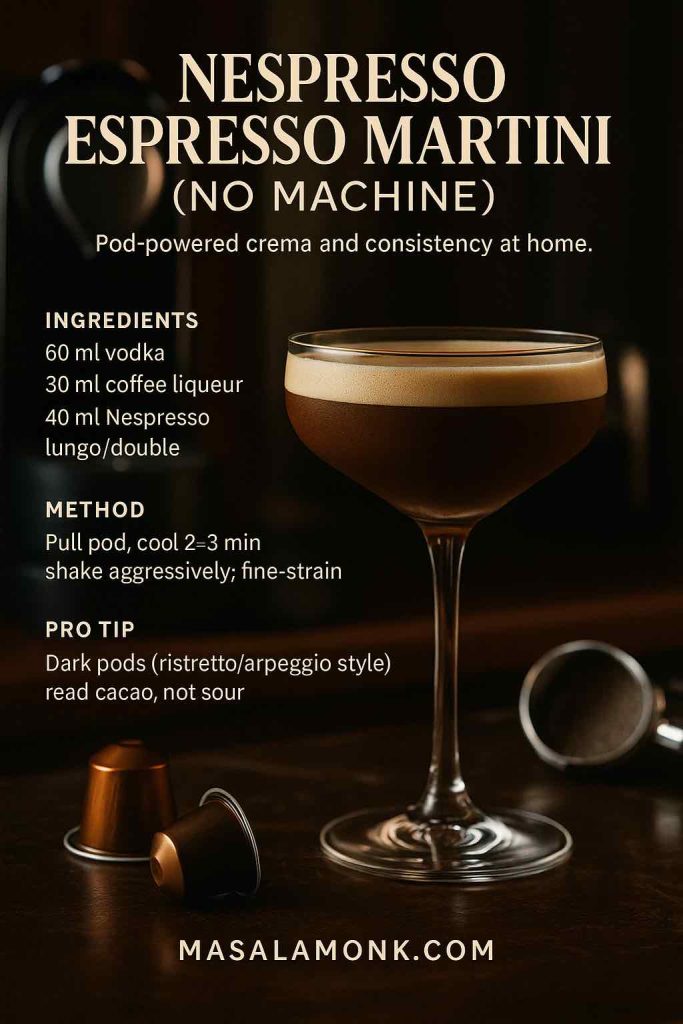
Method
Meanwhile, chill the glass. Pull your pod, give it a short cool, then shake vigorously with the other ingredients and dense ice. Fine-strain for that lacquered surface.
Pod talk, briefly
Darker capsules (Ristretto/Arpeggio-style) push chocolate, toasted nuts, and low fruit; consequently, they sit beautifully with a little sugar and ethanol. If you rely on moka pots or cold-brew concentrate some nights, you’re still golden—MasalaMonk’s coffee walkthroughs compare strengths, grinds, and extraction styles so your espresso martini recipe remains balanced even when your gear changes.
Salted Caramel Espresso Martini Recipe
Here’s the cozy showstopper: sweet-salty, aromatic, and richly textural without becoming cloying.
Ingredients
- 45 ml (1½ oz) caramel or vanilla vodka
- 20 ml (⅔ oz) coffee liqueur
- 30 ml (1 oz) espresso
- 10–15 ml (⅓–½ oz) salted-caramel syrup

Method
Shake briskly; fine-strain; crown with a faint pinch of flaky salt over the foam. Optionally, half-rim with crushed toffee for celebratory sparkle.
Keep it elegant, not sugary
Caramel leans sweet; accordingly, lean on espresso bitterness and a touch of salt to keep shape. For a brand-tested frame of reference, study proportions on the Kahlúa espresso martini page and then scale syrup down until your finish snaps.
Holiday spinoffs
- Gingerbread: swap salted-caramel syrup for gingerbread syrup; grate nutmeg.
- Maple-sea salt: 10 ml maple + micro-pinch salt; express orange over the cap.
- Spiced warmth: infuse your vodka with a cinnamon stick for 2 hours; pull it out before it dominates, and then shake as usual.
Also Read: Mango Martini + 5 Variants of Classic Cocktail
Cointreau (Orange) Espresso Martini Recipe
Chocolate-orange fans, this one’s for you. With citrus oils dancing over a dark foam, the nose alone sells the first sip.
Ingredients
- 45 ml (1½ oz) vodka
- 20 ml (⅔ oz) coffee liqueur
- 15 ml (½ oz) Cointreau (go Grand Marnier for oakier depth)
- 30 ml (1 oz) espresso
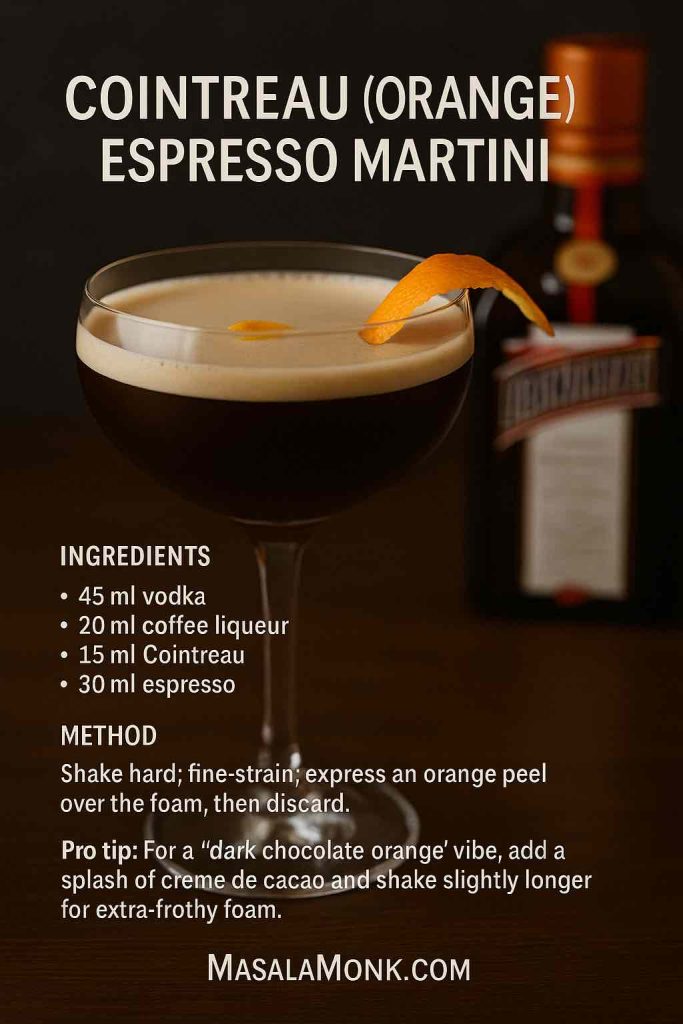
Method
Shake assertively; fine-strain; express a wide swath of orange peel over the surface and discard. The aromatic mist lands on the foam and blooms throughout the sip.
Flavor geometry, quickly
Cointreau is drier; thus the drink stays snappy. Grand Marnier reads richer, so trim any added syrup by 5 ml. For a “jaffa cake” vibe, add 5–10 ml crème de cacao; for a slightly bitter chocolate edge, toss in 2 dashes mole bitters.
Variants to slot under this heading
- Amaro lift: replace 10 ml of coffee liqueur with Averna; you’ll get cola-cocoa depth.
- Tequila twist: swap vodka for reposado; the orange plays beautifully with oak and vanilla.
- Burnt-orange finish: flame a peel (carefully) over the cap for caramelized aromatics.
Also Read: Vodka with Lemon: Easy Cocktails, Martini Twist & DIY Infusion
Mr Black Cold Brew Espresso Martini Recipe
When you want coffee to speak loudly and sugar to step back, Mr Black is the obvious lever. Their guidance also nails foam mechanics without fuss.
Ingredients (brand-style)
- 30 ml (1 oz) Mr Black Coffee Liqueur
- 30 ml (1 oz) vodka or reposado tequila for a drier, spicier frame
- 30 ml (1 oz) espresso or cold-brew concentrate
- 10–15 ml (⅓–½ oz) simple syrup, as needed
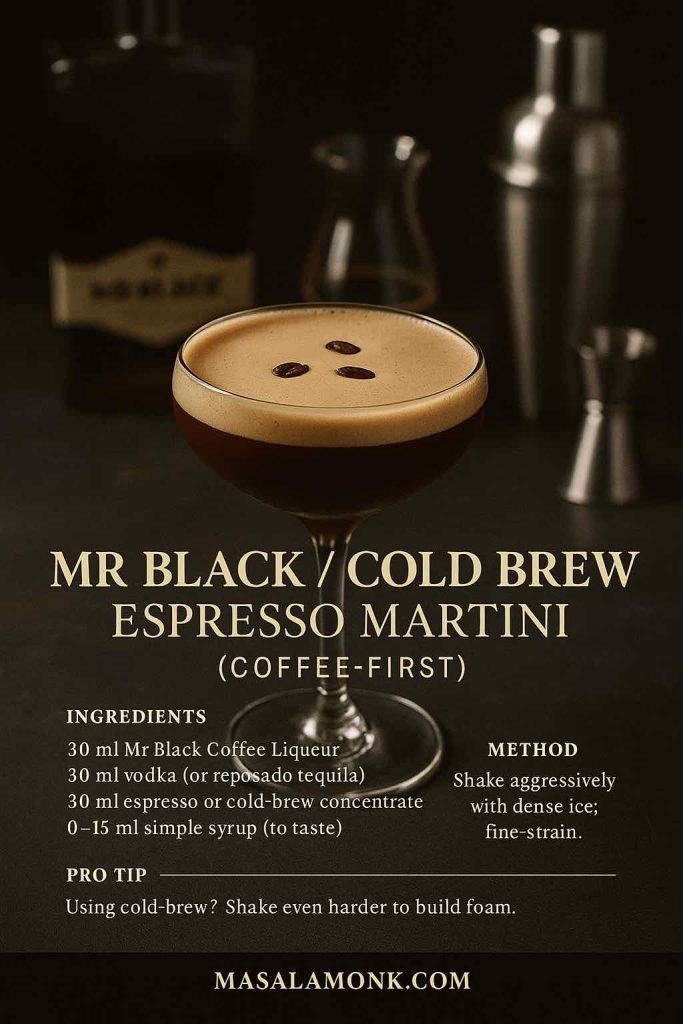
Method
Shake decisively; fine-strain; garnish with three beans or a coffee dust heart if you’re feeling fancy.
Practical notes
Cold-brew concentrate softens bitterness; consequently, you may want to reduce syrup so the finish stays crisp. For visual and method cues, peek at Mr Black’s espresso martini—their “shake hard for crema” mantra is exactly what brings this pour to life at home.
Variants to file
- Agave route: tequila base + orange express for a café de olla echo.
- Cocoa edge: 2 dashes chocolate bitters; serves like a mocha that grew up.
- Split base: 20 ml rye + 20 ml vodka; the spice peeks through gently.
Also Read: Daiquiri Recipe (Classic, Strawberry & Frozen Cocktails)
Licor 43 Espresso Martini Recipe (Spanish Vanilla)
Silky vanilla, bright citrus whispers, and a honeyed line through the middle—this riff drinks like a well-lit café at dusk.
Ingredients
- 30 ml (1 oz) Licor 43
- 30 ml (1 oz) vodka
- 40 ml (1⅓ oz) hot espresso
- Optional: 10–15 ml (⅓–½ oz) coffee liqueur for deeper roast
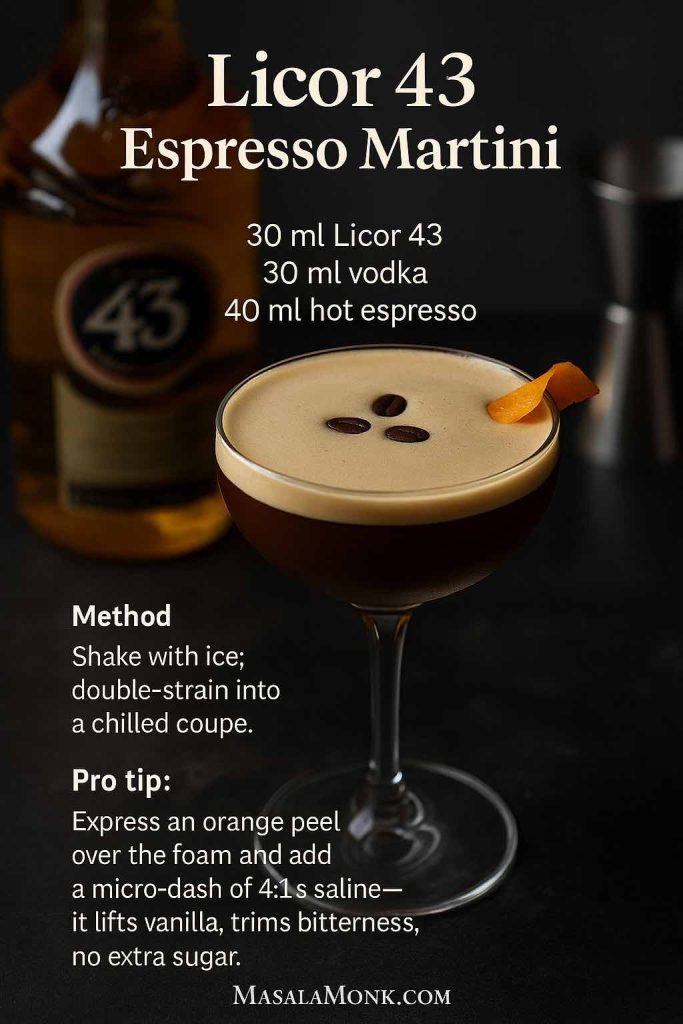
Method
Shake hard; double-strain into a chilled coupe; float a delicate orange twist and discard. The aroma cues vanilla, then the espresso anchors the sip.
Where to benchmark
Start with the structure and sweetness targets of Espresso 433; then decide whether you prefer “lean vanilla” (no added coffee liqueur) or “round café” (+15 ml).
Spin-offs
- Golden rum swap: trade vodka for a light aged rum; the vanilla threads feel seamless.
- Oat-vanilla cream: 10 ml unsweetened oat creamer in the shaker; shake longer for a silkier cap.
- Cinnamon touch: a single small stick infused in vodka for 60–90 minutes, then removed; build the drink as usual.
Also Read: Coconut Water Cocktails: 10 Easy, Refreshing Drinks
Peanut Butter Whiskey Espresso Martini Recipe
Decadent without being heavy, this one reads like a peanut-butter truffle kissed by espresso. It’s playful, memorable, and wildly “one more round” friendly.
Ingredients
- 45 ml (1½ oz) peanut-butter whiskey (Skrewball-style)
- 20 ml (⅔ oz) vodka or bourbon for oak and spice
- 20 ml (⅔ oz) coffee liqueur
- 25–30 ml (¾–1 oz) espresso
- Optional: 5 ml simple if your PB whiskey runs dry (rare)

Method
Shake until your tins sweat; fine-strain; garnish with grated chocolate or a light ring of crushed roasted peanuts (keep it minimal so it doesn’t drink like a sundae).
Balance pointers
PB whiskey is typically sweet; therefore, hold back on syrup and let espresso’s bitterness draw a clean perimeter. If you need a starting line, scan PB-centric riffs on coffee-liqueur recipe hubs (Kahlúa’s is an easy one to browse), then subtract sugar until the finish behaves.
Variants
- Cookie shop: +5 ml Frangelico (hazelnut); garnish with micro-zested nutmeg.
- Salty-sweet: a tiny saline dash plus chocolate bitters = “sea-salt brownie” energy.
- Bourbon bakery: swap vodka for a soft, vanilla-leaning bourbon; lower syrup to zero.
Also Read: Mango Vodka Cocktail: The Perfect Base + 7 Must-Try Variations
Vegan Espresso Martini Recipe (No Dairy, Big Foam)
You don’t need dairy to pour a towering cap. With the right technique, plant foams are terrific and—better yet—stable.
Ingredients
- 50 ml (1⅔ oz) vodka
- 25 ml (¾–1 oz) coffee liqueur (Mr Black if you want drier; Kahlúa if you prefer softer)
- 30 ml (1 oz) espresso
- 20 ml (⅔ oz) aquafaba or 15 ml vegan foamer
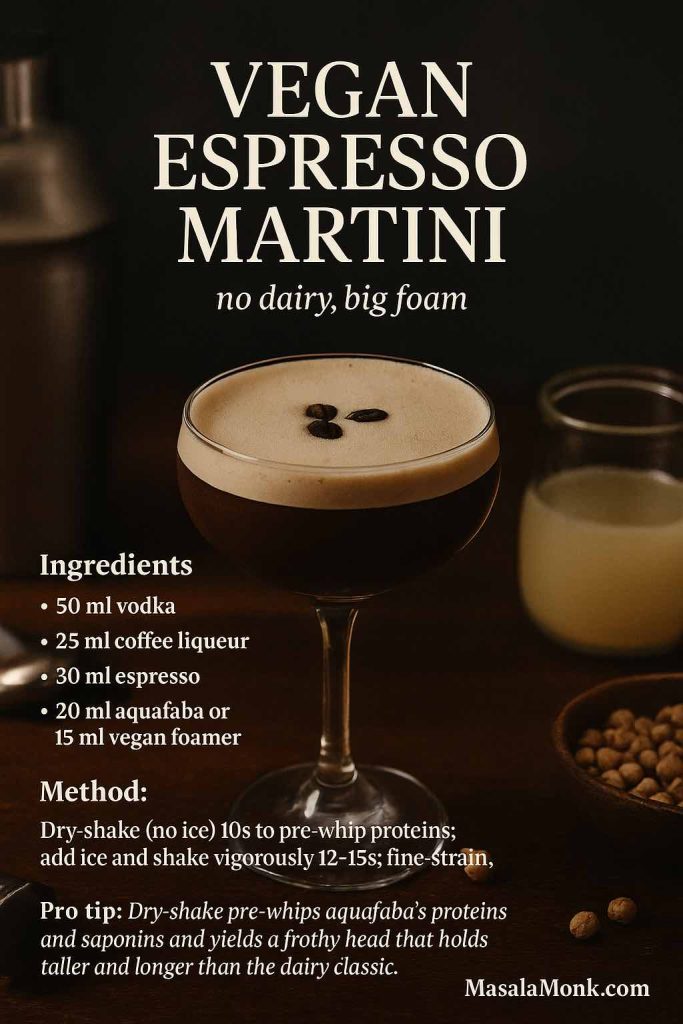
Method
- Dry-shake (no ice) for 10 seconds to pre-whip proteins.
- Add ice and shake vigorously for 12–15 seconds.
- Fine-strain; let the foam set for 10–15 seconds before garnishing.
Why aquafaba excels
Chickpea water brings proteins and saponins that trap air and stabilize bubbles; as a result, your vegan espresso martini recipe keeps that bar-style crown without egg whites. If you miss creaminess, you can also reach for non-dairy liqueurs or creamers; still, aquafaba remains the simplest pantry hack with dramatic payoff.
Plant-based variants
- Maple-cinnamon: 10 ml maple syrup + a dusting of Ceylon cinnamon.
- Chocolate silk: 5 ml crème de cacao + 2 dashes chocolate bitters; keep sweetness restrained.
- Orange blossom: a delicate spritz of orange blossom water over the foam—one pump is plenty.
Also Read: What to Mix with Jim Beam: Best Mixers & Easy Cocktails
Low-Cal Espresso Martini Recipe (Keto-Friendly)
Lean, aromatic, and still foamy, this build proves you can keep calories in check without sacrificing ceremony.
Ingredients
- 60 ml (2 oz) vodka
- 30 ml (1 oz) cooled espresso
- 5–10 ml (¼–⅓ oz) 1:1 allulose or erythritol syrup or a tiny dash of liquid stevia
- 2–3 dashes coffee or chocolate bitters (optional)

Method
Shake very hard to aerate; fine-strain. Express a lemon peel across the surface and discard to lift the nose without adding sugar.
Taste management
If the sip reads hollow, add two things before you reach for more sweetener: a saline micro-dash (which increases perceived sweetness) and a stronger coffee shot (which adds structure). Conversely, if the drink feels sharp, introduce 5 ml demerara syrup or 10 ml unsweetened almond-coconut creamer and shake a beat longer.
Keto-friendly riffs
- Vanilla-cocoa: ¼ tsp unsweetened cocoa, shaken in; 2 dashes vanilla extract.
- Orange-bright: 2 dashes orange bitters + orange express; no change in macros.
- Amaro-lite: 10 ml low-sugar amaro to add herbaceous depth; maintain sweetener as is.
Also Read: Whiskey and Warmth: 5 Cinnamon-Spiced Iced Tea Cocktails to Get You through Wednesday
How to Batch Any Espresso Martini Recipe (Entertaining Shortcut)
After the fifth order, shaking to order stops being charming. Batching preserves sanity while still delivering foam—if you mimic dilution strategically.
Scaling formula (serves ~8)
- Multiply any spec ×8.
- Add 200–240 ml cold water (this pre-dilution mimics the water your ice would add).
- Chill at least 2 hours (overnight is better).
- For service, shake each ~120 ml portion with fresh ice for 8–10 seconds; fine-strain.
Why this works
Most shaken cocktails dilute ~20–25%. Without compensating, a batched espresso martini recipe tastes hot and syrup-heavy. Pre-dilution lands you near your target texture before the finishing shake re-aerates for foam.
Flavor lanes for parties
- Spiced holiday tray: split your coffee liqueur with crème de cacao; express orange over each pour.
- Coffee-first crowd: go Mr Black as the sole liqueur; offer simple syrup on the side for guests to tailor.
- Dessert finale: run the Baileys + Kahlúa spec; rim half the glass with micro-grated chocolate for drama.
Also Read: Punch with Pineapple Juice: Guide & 9 Party-Perfect Recipes
Ingredient & Technique Notes You’ll Actually Use
Because the build is simple, tiny choices have outsized impact. Therefore, consider the following your pocket checklist.
Espresso temperature
Shake with a fresh, hot shot whenever possible. Cooling collapses crema and steals foam. If you’re troubleshooting thin caps, this single change solves half the cases.
Ice quality
Use dense cubes—slushy, hollow ice under-aerates and over-dilutes. Moreover, don’t overshake to compensate; instead, shake with real intent for a shorter, more forceful window.
Sweetness control
Think in 5 ml moves. Each nudge is noticeable in a small, spirit-forward drink. If your palate leans dry, use a roastier liqueur like Mr Black and rely on espresso oils for mouthfeel.
Saline, respectfully
Keep a 4:1 water-to-salt dropper. One micro-dash can focus flavors like magic, yet two will taste like soup—so proceed judiciously.
Citrus oils
Express lemon for lift or orange for warmth, ideally over the foam so aromatic droplets ride the cap into each sip. It’s a tiny flourish that reads “bar-quality” instantly.
When you want sources to cross-check, quickly:
- Canonical ratios and the three-bean tradition live at the IBA’s espresso martini entry.
- Technique nuances (hot shot, optional saline, sugar logic) are documented clearly on Difford’s Guide.
- Brand builds you can adapt fast come from Kahlúa’s how-to, the coffee-forward Mr Black recipe, and the vanilla-glow Licor 43 Espresso 433.
Flavor Map: Choosing the Right Espresso Martini Recipe Tonight
Because the differences are small but consequential, here’s how to steer without second-guessing:
- Want timeless and taut? Pour the Classic; match your sweetness to your liqueur; crown with three beans; optionally check the IBA reference if you’re a spec purist.
- Hosting dessert lovers? The Baileys + Kahlúa riff wins rapidly; if you need ideas for complementary garnishes or side sips, browse What Mixes Well with Baileys? and grab a chocolate-orange note or two.
- No espresso machine today? Pod crema is your friend; shake like a drum solo and fine-strain.
- Leaning cozy and festive? Salted caramel with a micro-pinch of salt and an orange express; for deeper winter vibes, tap 5 Spiced Espresso Martini Recipe Ideas and let cardamom or clove peek through.
- Coffee-first minimalism? Mr Black + vodka + espresso; adjust syrup downward; serve brisk.
- Vanilla-citrus glow? Licor 43 with a bright orange express; sanity-check sweetness against Espresso 433.
- Playful dessert-bar energy? Peanut-butter whiskey with a whisper of chocolate bitters; keep the finish clean.
- Plant-based crowd? Aquafaba dry-shake first; then ice; then fine-strain—towering cap, zero dairy.
- Counting macros? The Low-Cal pathway with bitters and lemon oil keeps things lifted without sugar creep.
Troubleshooting, Rapid-Fire (Fix It Mid-Service)
- Foam too thin: pull a fresh shot; shake with conviction; fine-strain.
- Over-sweet: skip syrup; choose a drier liqueur; add a micro-dash saline.
- Harsh finish: use a darker, chocolate-leaning coffee; add 5 ml demerara; shake 2 seconds longer.
- Watery: your ice is soft or your shake is timid and long—swap cubes; shake shorter but harder.
- No machine nights: moka, pods, or cold-brew concentrate are not compromises; they’re alternate routes.
One More Round (Interlinking for curious readers)
If you’re in the groove and want a different citrus-kissed classic for the next round, pop over to MasalaMonk’s Lemon Drop Martini for a bright palate reset between richer pours. And whenever you’re planning a holiday board, keep What Can You Mix with Kahlúa? and What Mixes Well with Baileys? open—those suggestions translate directly into simple, delicious espresso-martini garnishes and side sippers.
The Last Sip
Mastering the espresso martini recipe unlocks a flexible canvas. With a hot shot, a decisive shake, and sweetness in measured nudges, you can glide from taut and timeless to creamy and celebratory—or pivot into citrus-perfumed elegance, vanilla-glow warmth, plant-based lift, or low-cal clarity—without restocking half the bar. Consequently, you get repeatable results and room to play. And as your seasons change, your pantry will keep up: a different syrup here, a dash of bitters there, an orange express when you need polish. From intimate nightcaps to bustling parties, this family of recipes gives you structure first, then freedom—exactly what a modern classic should.
FAQs
1. What is in a classic espresso martini recipe?
A timeless build includes vodka, coffee liqueur, and fresh hot espresso; optionally, a touch of simple syrup balances bitterness. Consequently, shaking hard with dense ice creates the glossy foam cap people love.
2. How do I get a thick, long-lasting foam on my espresso martini recipe?
Use a fresh, hot espresso shot, shake vigorously for 12–15 seconds, and fine-strain into a chilled coupe. Moreover, dense ice and a decisive shake trap air, while a brief rest (10 seconds) lets the foam set before garnishing.
3. Can I make an espresso martini recipe without an espresso machine?
Absolutely. Alternatively, use a strong Nespresso double shot, moka pot concentrate, or robust cold-brew concentrate (1:1 to espresso volume). Nevertheless, shake with conviction to build comparable crema.
4. What’s the best coffee for an espresso martini recipe—light, medium, or dark?
Choose medium-dark to dark roasts for chocolate, caramel, and nut notes. Conversely, very light roasts can taste citrusy and thin once chilled and sweetened.
5. Do I need simple syrup, and how much should I add?
Not always. Start at 0–10 ml per drink; subsequently, adjust in 5 ml steps until the finish feels balanced rather than sugary. Importantly, sweeter liqueurs may require no added syrup at all.
6. Which vodka is best for an espresso martini recipe?
A clean, mid-to-high proof vodka with minimal burn is ideal. Furthermore, chill the bottle to improve texture and reduce perceived sharpness.
7. Can I swap vodka for gin, tequila, or rum in an espresso martini recipe?
Yes. Gin adds juniper lift; reposado tequila brings vanilla-oak warmth; aged rum contributes caramel depth. Likewise, reduce any added syrup by 5 ml if the base spirit tastes naturally sweet.
8. What’s the difference between Kahlúa, Mr Black, and Licor 43 here?
Kahlúa skews sweeter and rounder; Mr Black reads roastier and drier; Licor 43 layers vanilla-citrus. Consequently, the sweeter the liqueur, the less extra syrup you’ll need.
9. How do I make a Baileys and Kahlúa espresso martini recipe without it becoming heavy?
Keep Baileys at 30 ml, Kahlúa at 15 ml, and shake colder and harder. Additionally, fine-strain to remove ice chips that can collapse the foam and muddy the texture.
10. Can I make a vegan espresso martini recipe with real foam?
Definitely. Use 20 ml aquafaba and dry-shake first, then shake with ice. Notably, aquafaba’s proteins and saponins stabilize bubbles, yielding a tall, silky cap.
11. Is egg white okay in an espresso martini recipe?
It’s optional. Egg white increases foam density and softness; however, it slightly mutes aromatics. If used, dry-shake first to pre-whip, then ice-shake to finish.
12. How do I batch an espresso martini recipe for a party?
Multiply your spec, then add 20–25% cold water to mimic dilution. Subsequently, chill at least 2 hours. To serve, shake each portion briefly with ice for fresh foam.
13. How long will a batched espresso martini recipe keep in the fridge?
Up to 24 hours for best flavor. Meanwhile, keep coffee and spirits mixed but add dairy (if any) just before serving; otherwise, separation and dull flavors creep in.
14. What glass should I use—and does it affect foam?
A chilled coupe or Nick & Nora is perfect. Importantly, cold, clean glassware helps the foam dome hold shape and aroma longer.
15. Why does my espresso martini recipe taste bitter or hollow?
Bitter: your coffee is too light or over-extracted; add 5 ml demerara or a micro-dash saline. Hollow: your coffee is weak; strengthen the shot or reduce water in concentrate. Ultimately, balance emerges with small 5 ml tweaks.
16. Can I use instant coffee in an espresso martini recipe?
Yes, in a pinch. Mix 1 tsp quality instant coffee with 30 ml hot water for a quick “espresso.” Additionally, consider 5 ml extra syrup to tame potential harshness.
17. What are the best garnishes for an espresso martini recipe?
Three coffee beans are classic; alternatively, try an orange peel express, a cocoa dusting, or shaved dark chocolate. Likewise, keep garnishes light so they don’t sink the foam.
18. How do I keep the drink from tasting too sweet with flavored syrups (salted caramel, vanilla)?
Start with 10 ml syrup and taste; consequently, reduce or add salt (a tiny pinch) to sharpen definition. Conversely, increase espresso by 5 ml if flavors feel candy-like.
19. Can I make a low-calorie or keto espresso martini recipe?
Yes. Use vodka, espresso, and a zero-cal sweetener syrup (5–10 ml). Moreover, add 2–3 dashes chocolate or coffee bitters and a lemon-peel express to boost perceived sweetness without sugar.
20. What’s the ideal shake time and technique?
Aim for 12–15 seconds with dense ice; shake with big arcs and firm snaps to maximize aeration. Subsequently, fine-strain immediately while the foam is lively.
21. Should espresso be hot or cooled before shaking?
Prefer hot, freshly pulled espresso for superior foam; however, Nespresso or moka shots can cool 1–3 minutes to avoid over-dilution. Notably, don’t let crema collapse entirely.
22. Can I make an espresso martini recipe without coffee liqueur?
You can, though flavor changes. Use vodka, espresso, and demerara syrup; then add chocolate or coffee bitters for depth. Conversely, expect a leaner, less rounded profile.
23. What’s the best ratio for an espresso martini recipe if I like it drier?
Try 60 ml vodka, 20–25 ml coffee liqueur, 30 ml espresso, and 0–5 ml syrup. Additionally, a micro-dash saline can enhance perceived sweetness without sugar.
24. How do I avoid watery or thin results?
Use solid, large ice; shake decisively but not excessively long. Furthermore, pre-chill glassware and spirits, and fine-strain to keep tiny shards from melting on the surface.
25. Can I use decaf and still get great foam?
Yes—choose a full-bodied decaf espresso or concentrate. Likewise, keep the shake energetic; foam depends more on technique and freshness than caffeine content.
26. What’s the easiest way to switch flavors without changing the whole espresso martini recipe?
Swap liqueurs (e.g., Licor 43 for vanilla, Mr Black for roasty), trade bases (gin, tequila, rum), or change syrup (salted caramel, maple, gingerbread). Consequently, adjust sweetness and garnish to match the new direction.
27. How much salt is safe to add to an espresso martini recipe?
Use a 4:1 water-to-salt saline and add a single small drop. Importantly, salt should be invisible—enhancing sweetness and rounding bitterness without tasting salty.
28. Why fine-strain an espresso martini recipe?
Fine-straining removes micro-ice that can puncture the foam and over-dilute the drink. Additionally, it leaves a smooth, glossy surface for consistent presentation.
29. Can I serve an espresso martini recipe over ice (“on the rocks”)?
You can, though it changes the style. Subsequently, expect faster dilution and softer foam; therefore, reduce syrup slightly and consider a large clear cube to slow melt.
30. What calorie range should I expect?
Generally 130–220 kcal per serving depending on liqueur sweetness and cream additions. Conversely, low-cal versions with zero-cal sweeteners and no cream trend toward the lower end.
31. Any quick fixes if the foam collapses at the table?
Gently “wake” the glass by tapping the stem to re-settle bubbles; meanwhile, serve immediately after shaking, and avoid over-pouring—shallower fill heights keep the cap intact.
32. How do I choose between Kahlúa, Mr Black, and Licor 43 for my crowd?
For dessert-leaning palates, pick Kahlúa; for coffee purists, choose Mr Black; for vanilla-citrus lovers, pour Licor 43. Ultimately, align liqueur personality with your guests’ dessert preferences.
33. Can I add cream or oat creamer to an espresso martini recipe?
Yes, sparingly (10–15 ml). Additionally, shake longer to re-emulsify; otherwise, texture turns flabby. Oat versions remain lighter while still plush.
34. What’s the simplest “best espresso martini recipe” starting ratio?
As a baseline: 60 ml vodka, 30 ml coffee liqueur, 30 ml hot espresso, 0–10 ml syrup. Thereafter, tweak sweetness in tiny steps and lock your house spec.

